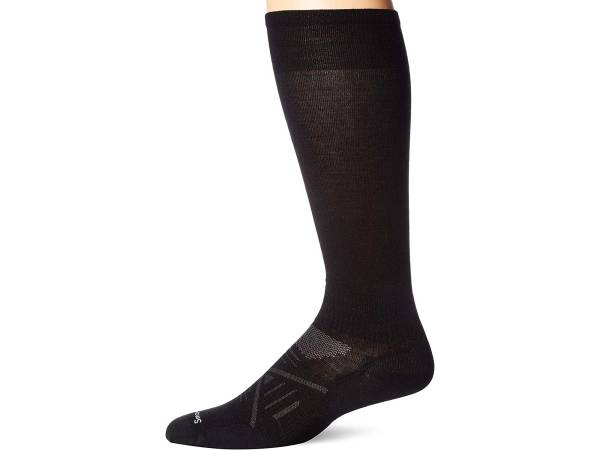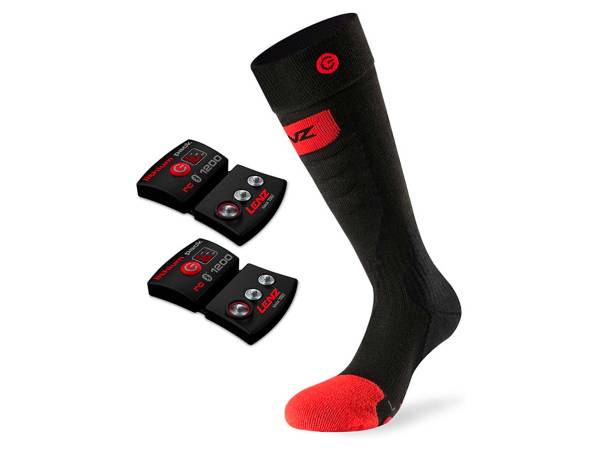We may earn revenue from the products available on this page and participate in affiliate programs. Learn More ›
It’s what’s underneath that counts. Yes, those expensive plastic ski boots you admire on chairlift rides have a lot to do with your skiing performance—and how warm your feet feel—but your ski socks are the true unsung, and unseen, heroes of comfort beneath all that skiing gear. You need the best ski socks because cold feet will stop you in your tracks.
When searching for the best ski socks—be they the best men’s socks, best women’s socks, or the best socks for cold feet—material matters. Merino wool is top of the heap right now because it naturally resists odors, mitigates moisture and even keeps in heat after it gets wet. But synthetic materials like nylon-polyester can also provide excellent protection. Most ski socks today feature a blend of wool and synthetic, as well as some percentage of Lycra spandex or elastane for cling.
Once you’re matched up with the right composition of yarn and fabric, you need to determine how much of that material you need. Are you a speed chaser who wants an ultrathin, lightweight ski sock that maximizes foot-boot connection? Or do you prefer to sacrifice a few notches of MPH for dialed-up warmth and padding?
If you haven’t delved much into the value of ski socks—perhaps you’re someone who believes that two pairs of ski socks could actually be warmer than one—you’re about to discover that having the right pair can really, well, knock your socks off. The following will help you lay out the path to buying the best ski socks.
- Best for Durability: Darn Tough Alpenglow Over-The-Calf Light
- Best for Kids: OutdoorMaster Kids Ski Socks
- Best Moisture Wicking: Smartwool PhD Ski Medium
- Best Compression: Dissent Ski GFX Compression
- Best Lightweight: Smartwool PhD Ski Ultra Light
- Best Heated: Lenz Heated Socks 5.0
- Best Cheap: Fox River Telluride Medium
Features to Consider When Buying Ski Socks
When shopping for the best ski socks, you should look first at the blend of fabric. Those percentages of wool, synthetic and elastic materials will tell you how warm those socks should be, how well they will wick moisture and how tightly they will cling to your legs.
Ski socks are no longer the thick, itchy part of the ski outfit that your dad used when he was younger (in fact, consider getting him a new pair of ski socks as a gift). Socks made of merino wool and composite yarns are breathable and hold in heat, without making you feel as if you’ve got a pair of slippers under your ski boots. Some ski socks include added thickness in strategic locations to minimize wear and tear, and maximize comfort. However, that padding can limit control if performance is paramount.
Are You Looking for Durable Socks?
Ski socks take a beating, and you may want to wear them when you’re not skiing. If that’s the case, look for socks with a little extra padding in the heel, toes and shins. They’ll last and will limit any potential boot irritation.
Best Ski Socks for Durability: Darn Tough Alpenglow Over-The-Calf Light
Dang Durable
Made almost entirely of merino wool (56%) and nylon (42%), these are the best adult ski socks because they are made for the long haul—Darn Tough will replace them if they wear, tear, or develop holes. Yet, even with so much toughness, they still manage to have quite the soft side. The O-T-C Light provides plenty of comfort and warmth inside your boot, and the seamless build cuts out irritation.
Do You Need Kids Socks?
If you’re buying ski socks for a kid, buy ski socks sized for kids. An ill-fitting pair of adult socks on a kid will lead to discomfort and frustration on the slopes. Also make sure they are designed to not itch, for the same reasons.
Best Kids Ski Socks: OutdoorMaster Kids Ski Socks
Picture-Perfect Pair
These socks aren’t itchy, they don’t start to smell very easily, they stay pulled up, and they are machine washable. What else could Mom and Dad ask for when trying to find the best kids ski socks? The merino wool blend is lightweight with moisture-wicking properties, and the scenic design, which comes in a variety of color options, features a snow-capped mountain under puffy clouds.
Do You Need Moisture-Wicking Socks?
One of the primary ways the best ski socks keep your feet warm is to wick moisture away from your soles. Breathable merino wool has an uncanny ability to stop the sweat from sticking to your skin. But that doesn’t mean the socks suddenly feel damp and heavy. Merino wool fibers absorb moisture naturally, meaning you have to sweat a ton before your wool ski socks start to feel squishy. If your feet perspire a lot on the slopes, get a pair of ski socks that will wick moisture away from your skin.
Best Moisture Wicking Ski Socks: Smartwool PhD Ski Medium
Dry and Comfortable
For the ideal blend of warmth, comfort and reliability, this is the smartest choice. The 65% merino wool pair will keep your toes toasty while wicking sweat away. It’s a slight step down in durability from the Darn Tough, but it does boast “indestructawool technology”—a thick wool padding added to high-impact areas—to increase the life of the sock.
Do You Need Compression Socks for Circulation?
Wearing compression ski socks that are extra snug help blood flow through your lower extremities. Doctors often prescribe compression socks to patients with poor circulation or a history of blood clots, and compression ski socks can also benefit active skiers who simply want a little boost.
Compression ski socks tend to be more expensive than traditional-fitting ski socks, but that’s because they squeeze in the same wicking, warming and comforting properties along with that helpful assist to your circulation.
Best Compression Ski Socks: Dissent Ski GFX Compression
Gets Blood Pumping
There’s really no argument: These Dissents are the best compression ski socks. Made of a synthetic blend with extra padding under pressure points, they offer the comfort you desire and the snug fit you expect. While the downside is price—they are double the cost of some other leading ski socks—they won’t let you down on performance.
Do You Want Lightweight Ski Socks to Improve Your Control?
High-performance racing ski boots are built to be tight. After all, the more your foot and boot can move as one, the better control you’re going to have. And in races that often come down to fractions of a second, millimeters of space between the bottom of your foot and the top of your boot lining can make the difference between the top and the bottom of the standings.
Lightweight socks are thin ski socks designed to fit into snug boots, which, of course, have their own included lining to keep you comfortable. Modern materials mean light ski socks can still keep your feet warm and dry (but of course a heavier merino wool-based sock will be toastier and more durable than a thinner ski sock crafted with the same material). But if you want the most control possible, lightweight ski socks are the answer.
Best Lightweight Socks: Smartwool PhD Ski Ultra Light
Thin for the Win
Featuring all the sweat-wicking and stink-suppressing prowess that makes Smartwool so popular, these best lightweight ski socks will fit easily into even the tightest racing boot. The merino wool, nylon and elastane blend offers the comfort you desire, and the thinness maximizes your foot’s connection to the boot.
Do Your Feet Get Cold Very Easily?
You’re on the chair for the first run of the day, and you’re already griping about frigid feet. If that happens often, you should consider a pair of heated ski socks. Using batteries and carbon fiber wires, heated ski socks pump warmth throughout the sock.
You’ll surely pay a higher price to have a portable heating system inside your ski boot, but you really are getting more for your money—the best heated ski socks are made from the same material as regular ski socks, meaning they will perform even when they aren’t turned on.
Best Heated Ski Socks: Lenz Heated Socks 5.0
Toasty Toes
Control the warmth of these best heated ski socks via a smartphone app. The batteries can last up to 14 hours, depending on the temperature setting. And because these Lenz are made from a quality mixture of synthetic materials and merino wool, they will keep your toes plenty warm after that. While these super heaters cost more than a pair of cheap ski boots, you’ll be happy you have them when the mercury is dropping on the chair ride to the top.
Are You Looking for the Best Ski Socks on a Budget?
Ski socks are critical to comfort on the slopes, but if you’re looking to spend as little as possible, you can absolutely find cheap ski socks that will do the job. You’re going to lose out on some of the versatility and durability, but you can still expect to get something that wicks well for several years.
Best Cheap Socks: Fox River Telluride Medium
Budget Pick
These Fox River socks provide plenty of sweat wicking and warmth that’ll last all day. The synthetic blend makeup, which features only 18% merino wool, won’t perform quite as well as pricier pairs, but if all you need is something to keep your toes toasty and dry, these are a nice pick. Plus, they feature extra fabric on the shin, ankle and heel, meaning they will pad more than just your wallet.
FAQs
Do ski socks make a difference?
Yes, ski socks make a difference. If you’ve ever worn cotton socks while exercising, you know this all too well. Materials like merino wool sweep the sweat away without locking in that cold, damp feeling. Plus, if a ski sock is too thick or thin for your boot, you’re setting yourself up for irritation.
How thick should ski socks be?
Ski socks shouldn’t be as thick as they once were. Merino wool and synthetic yarn allow ski socks to keep your feet cozy without weighing you down. Even thin ski socks designed to optimize control for the speediest skiers can wick sweat and retain heat. But for extra protection on your shins and heels—not to mention increased warmth—look for thicker socks that provide a touch more cushioning.
A Final Word on Shopping for the Best Ski Socks
Focus on fabric and sweat-wicking ability. These qualities are the top takeaways. If your ski socks keep you dry, warm and comfortable, you’ve found the best ski socks.







